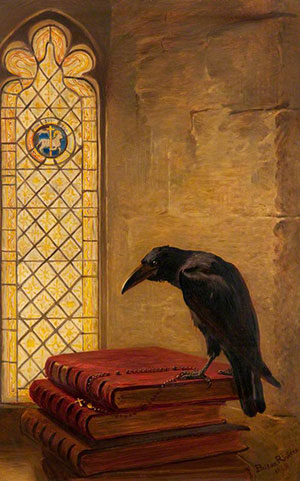
Source: Moods, John Rudolph, Wikimedia
Mood refers to the atmosphere or feeling that a writer creates in a literary work or passage. Watch this video to see examples of various moods.
Source: Tone & Mood Words, Marisa Hammond - Olivares, YouTube.com
All right—with so many moods possible, how can you determine which ones an author intends? Figurative language is especially helpful in determining mood, so you can look at the language the author used. Read the following poem and notice the figurative language and sound devices, then complete the exercise below to show how these devices reveal mood.

Source: Briton Rivière – A Saint, from the “Jackdaw of
Rheims”, Wikimedia,
The Raven
By Edgar Allan Poe
Once upon a midnight dreary, while I pondered, weak and weary,
Over many a quaint and curious volume of forgotten lore—
While I nodded, nearly napping, suddenly there came a tapping,
As of some one gently rapping, rapping at my chamber door.
“’Tis some visitor,” I muttered, “tapping at my chamber door—
Only this and nothing more.”
Ah, distinctly I remember it was in the bleak December;
And each separate dying ember wrought its ghost upon the floor.
Drag and drop the examples of figurative language to their types.

Now, click on the box next to the mood words that fit this passage based on the figurative language text evidence you used above.


Source: Sun, Tom Magilery, Flickr
You have now learned how figurative language creates imagery, appeals to the senses, and suggests mood. Here is a simile for you: I hope your day is as bright as the sun!